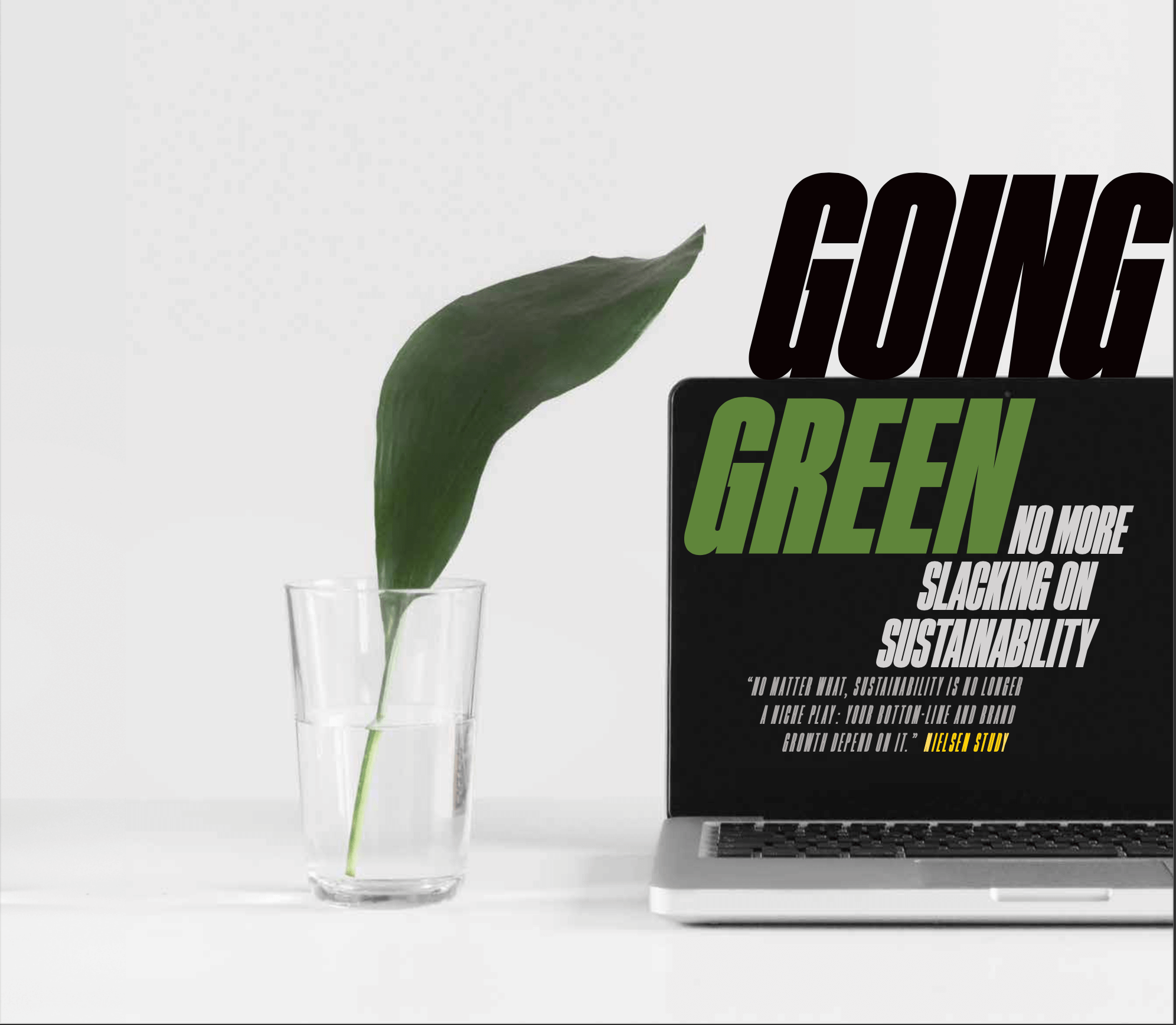
28 Jun Going Green: No More Slacking on Sustainability
Maybe we’ve just been too busy struggling to survive.
How else to explain the apparent dearth of any — or any substantial — environmental sustainability initiatives at many media companies?
After a rush of sustainability policy activity about ten years ago when the topic was initially hot, going green in the media lately seems to have been reduced to creating print and/or digital editions or big text or digital packages about climate change spelling out how businesses, governments, and our readers can and should become good environmental citizens.
But as far as we ourselves becoming good environmental citizens goes…
Well, we’re either doing a terrible job telling people what we’re doing, or we really have been too distracted with the other, more basic tasks of figuring out how to survive and thrive.
To be fair, some media companies have created environmental sustainability mission statements. Some have identified measurable goals to reduce their environmental impact. Some have established internal teams to examine their own practices and processes with an eye toward reducing or eliminating any that were environmentally harmful. And some have even published the results of their efforts.
But a review of the 30 largest media companies in the world and a random search of other large media companies reveals that many don’t have sustainability policies or goals, and of those that do, many of the mission statements and goals have either never been substantiated with progress reports or their progress reports have not been updated in many years.
(I hereby invite you, if you have sustainability mission statements, measurable goals, and progress reports, to please reach out to me for next year’s book — wilpers@innovation.media.)
Multiple Google searches for sustainability’ activities by media companies turned up virtually nothing. That result reinforces the conclusion that, if we actually are doing sustainable things, then we are terrible at marketing ourselves to a public increasingly aware of and expecting corporations to actively and aggressively take responsibility for their environmental impact and take action to reduce it. To make their point, consumers are supporting such companies with their money, and abandoning those who don’t.
Virtually everyone on the planet is now increasingly aware of the global climate crisis (with some notable, regrettable exceptions). Therefore, now is the perfect time to get really serious about sustainability.
And guess what? It’s a win-win-win proposition. Sustainability activities deliver a tripleplay of benefits:
1. Improved consumer relations: Studies have shown consumers prefer to support companies with a track record of sustainable practices
2. Bottom-line savings: Studies have shown that you can actually improve your bottom line by implementing sustainable initiatives
3. Saving the planet: After an initial environmental audit of your activities, you can subsequently prove that your efforts are reducing your carbon footprint, among other things. What’s not to like about that?
A recent study by global data firm Nielsen examining the consumer journey to demand sustainability from corporations concluded bluntly:
“No matter what, sustainability is no longer a niche play: your bottom-line and brand growth depend on it.”
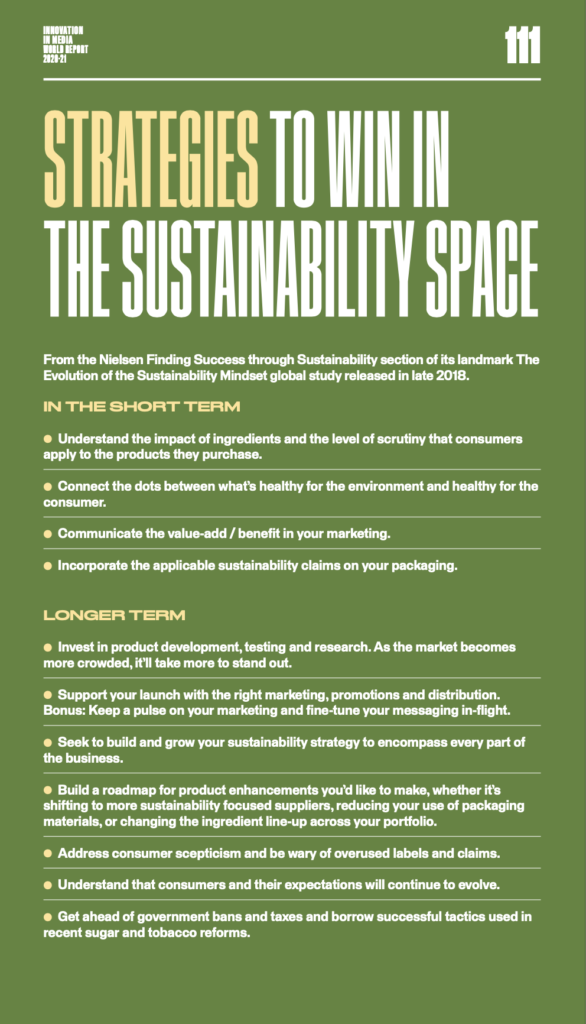
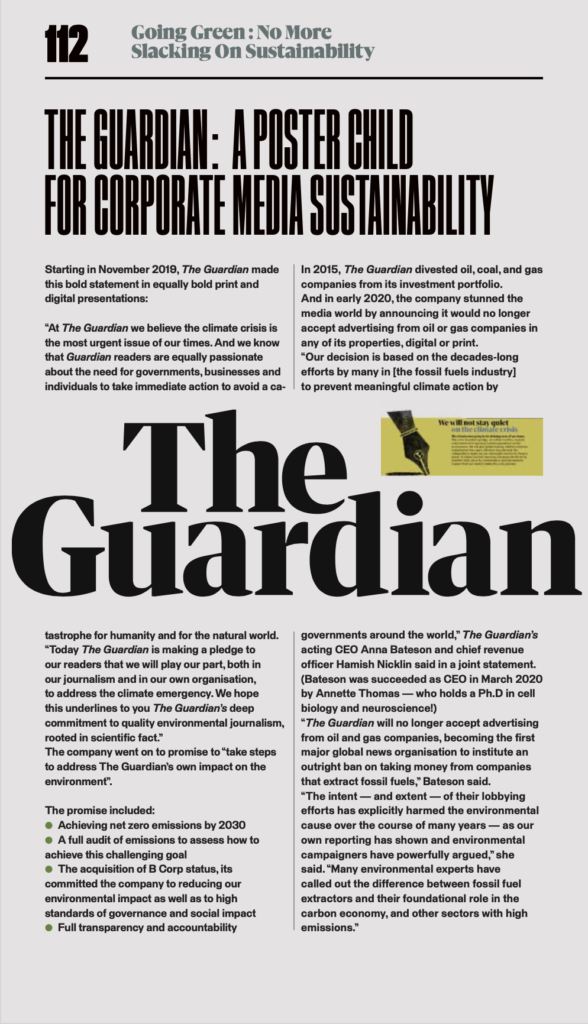
1.IMPROVED CONSUMER RELATIONS
(OR DOING WHAT YOUR CONSUMERS ARE ALREADY DEMANDING OF YOU)
“Corporate responsibility and sustainability strategies may take different shapes around the world, but one thing is clear: consumers are using their spending power to effect the change they want to see,” said Regan Leggett, Executive Director of Nielsen’s Global Thought Leadership and Foresight Team.
“This isn’t a trend a company can simply side-step,” he said. “Sooner or later, whether through government regulation, sheer force of nature, or public outcry, companies will need to respond. No matter what market you’re in, connecting sustainability factors to how it impacts consumers is the key.
“Sustainability has become an urgent opportunity for companies to connect with consumers who are excited about change,” said Leggett.
Nielsen’s late-2018 global study, The Evolution of the Sustainability Mindset, found that:
• A whopping 81% of global respondents said they felt strongly that companies should help improve the environment
• Four-fifths of young people demand corporate social responsibility regarding sustainability: Millennials (85%), Gen Z (80%) and Gen X (79%)
• More than two-thirds of older generations also demanded corporate sustainability commitments: Baby Boomers (72%), the (over-70) Silent Generation (65%)
Another sustainability survey of consumers by B2B research company Clutch found:
• Almost three-quarters (71%) of respondents considered a company’s environmentally friendly business practices more important than the prices of that company’s goods by almost 30 percentage points (44%). “When a company shares their consumers views and values and helps contribute to solving a problem everyone agrees is a problem, consumers are going to want to keep working with or buying from that company,” Josh Weiss, CEO of 10 to 1 PR told Clutch
This consumer demand for corporate sustainability commitments and action is not a movement only in places like the US or famously environmentally activist countries like Sweden and Norway. As a matter of fact, it’s quite the opposite. None of the countries with the highest consumer demand for corporate climate accountability were in North America or Europe:
1. India (97%)
2. Columbia (96%)
3. Mexico (95%)
4. Indonesia (94%)
5. Philippines (94%)
6. Brazil (94%)
7. Venezuela (94%)
8. Pakistan (92%)
9. Argentina (92%)
10. Chile (92%)
11. Peru (92%)
“Facing rapid urbanisation and a growing disparity between classes, many people in emerging markets are experiencing the harsh reality of pollution in this post-modern industrial age,” said Leggett. “As a result, sustainability has become an urgent opportunity for companies to connect with consumers who are excited about change.”
“Sustainability is personal for consumers, which is why ‘healthy for me’ and ‘healthy for the world’ claims do so well,” said Crystal Barnes, SVP, Nielsen Global Responsibility & Sustainability. “By identifying an opportunity to be more sustainable, and implementing a reasonable plan of action to accomplish it, companies achieve an authenticity that paid advertising can’t buy.”
The Nielsen study found that companies are under increasing pressure from consumers and governments to be reactive initially and proactive shortly thereafter in terms of sustainability.
According to the Nielsen report, “brands that are able to strategically connect [sustainability] to actual behaviour are in a good place to capitalise on increased consumer expectation and demand”.
The report adds that “sustainability claims on packaging must also reflect how a company operates inside and out”. Media companies can make sustainability claims on both their paper and digital products, prominently touting their environmentally friendly initiatives and results.
More and more companies are doing that and going beyond. “What’s growing is the boldness of the marketing messages and the commitments that brands are willing to take,” said Barnes.
“We’re seeing a bigger trend towards visible and emotional sustainability’— brands taking a stance on social and political issues and making major commitments to eliminate waste,” said Barnes. “At the most extreme end, we see brands being personified — being referenced as ‘brave brands’ or ‘hero brands’.”
This is an unusual opportunity for media companies where doing the right thing is also doing the most profitable thing from both a cost-savings and revenue-enhancement perspective.
“This is official validation for how energy and sustainability work together to boost your topline revenue growth and your profitability at the same time,” E Squared Energy Advisors CEO Tim Grosse told Entrepreneur.com.
“Your business can ride this tsunami wave by gaining market share from the rapidly growing number of environmentally responsible consumers or your business can lag the market and peers by ignoring this trend,” Grosse said.
Not really a choice, is it?
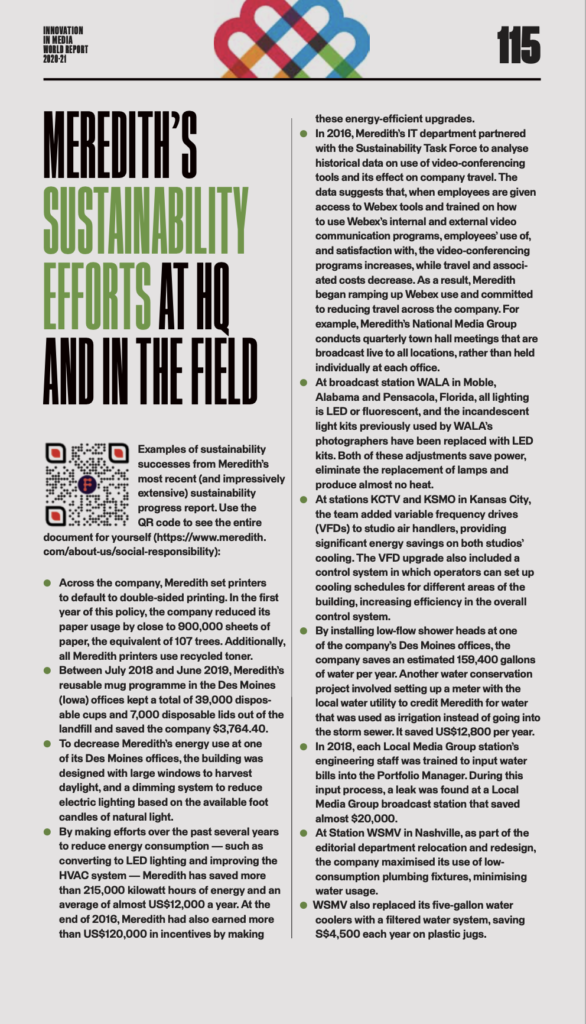
2. BOTTOM-LINE SAVINGS
In addition to increasing the loyalty of existing consumers and acquiring more consumers attracted by your sustainability efforts, you can actually save money by going green.
“Instituting more sustainable business practices can mean real cost savings, from lower energy costs to tax incentives, but businesses can also gain loyal clients and end-users looking to do business with like-minded organisations,” wrote Jim Granat, Head of Small Business at financial services company Enova International, on Forbcs.com.
Many companies have no idea what then-carbon footprint is. And there’s really only one way to find out.
“Start with reliable data,” wrote Granat. “Corporations can leave massive carbon footprints behind, but you may not know the full extent of your company’s trail without a comprehensive and honest end-to-end investigation.
“One way to truly put your business to the test is to hire a third-party sustainability consulting firm that analyses your entire process,” he wrote. “An unbiased firm can find ways to help you responsibly manage or reduce waste and energy usage in ways you may not have thought possible. Depending on the nature of your business, they can also help you source more responsible or sustainable materials, develop greener technologies, or even use less water.
“Salesforce Sustainability Cloud and similar ‘carbon accounting’ products can also shed light on opportunities to improve,” Granat wrote. “However you go about it, start with comprehensive, unbiased data, and try to keep an open mind.”
There are both short- and long-term actions you can take to be more sustainable, ranging from increased recycling and LED lighting to paper changes, eliminating plastic wrapping, and implementing smart tech to reduce waste.
Granat recommends involving your staff in brainstorming unique ways to reduce your carbon footprint.
After creating your sustainability mission and strategy, use your initial data as the baseline to measure your progress and regularly publish progress reports, including both successes and shortcomings in the interest of honesty and transparency.
Savings can be achieved in three, four, and five-figure sums, and range from the simple to more complex. For inspiration, see the side-bar on Meredith’s examples and check out the examples in the following section.
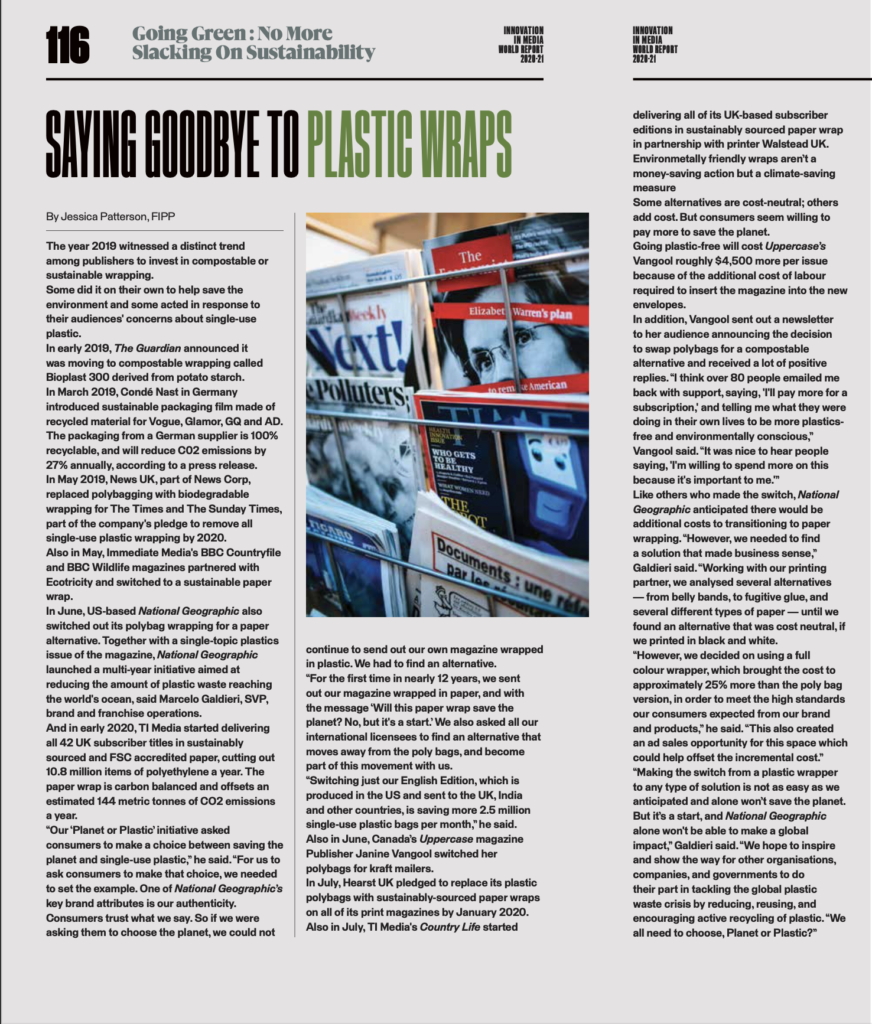
3. SAVING THE PLANET
The media companies that have created sustainability policies and strategies are having a significant impact on their (and our) environments based on their impressive progress reports against their aggressive sustainability goals.
For example, since April 2017 the BBC has been buying renewable electricity, which has contributed to a significant reduction in the company’s carbon footprint and supports its science-based reduction target. Since 2008, the BBC has saved more than 180,000 tonnes of C02, primarily through the concentration of its operations into fewer, more efficient buildings.
An impressive number of media companies are moving away from plastic wraps in favour of more environmentally friendly alternatives. For example, in 2019, The Guardian announced it was moving to compostable wrapping called Bioplast 300 derived from potato starch, which replaced its polybag wrapping. News UK, part of News Corp, switched to biodegradable wrapping for The Times and The Sunday Times, part of the company’s pledge to remove all single use plastic wrapping by 2020.
Also in 2019, two other media companies made the switch: Immediate Media’s BBC Coun-tryfile and BBC Wildlife magazines partnered with Ecotricity and switched to a sustainable paper wrap whilst Hearst UK pledged to replace its plastic poly bags with sustainably sourced paper wraps on all of its print magazines by January 2020.
But when it comes to a company-wide, top-to-bottom, internal and external commitment to corporate sustainability, Meredith takes the top prize. By a mile.
At Meredith, in 2008, the company created an environmental sustainability mission statement and a Sustainability Task Force to make it happen.
“Meredith Corporation has taken a proactive approach to environmental sustainability because such action ultimately benefits our shareholders, our clients, and our employees,” the statement reads. “This approach also demonstrates that companies can be responsible environmental stewards while simultaneously increasing business efficiency, and ultimately shareholder value.”
Among its many achievements, Meredith cites:
• Company-wide use of the EPAT — Environmental Paper Assessment Tool — to track the environmental performance of its paper suppliers and identify potential areas for improvements.
• The corporate headquarters recycles more office materials, such as cardboard, paper, and plastics, than it sends to landfills.
• The completion of a new greenhouse gas (GHG) emissions inventory to create a new baseline year (Fiscal 2019) and ensure its ability to track necessary data in all controlled locations per GHG Protocol guidelines.
• One of the company’s Des Moines headquarters offices was the first existing building in Iowa to be LEED certified. The office building Meredith occupies in New York is applying for LEED Gold certification, and Meredith’s office in Chicago has set a goal of becoming LEED certified in calendar year 2020.
• On the corporate level, Meredith’s actual tonnage of paper purchased from mills certified ISO 14001 (an environmental management standard for minimising their impact on the environment) increased from 49% to 69%.
• When printing, Meredith has moved to ink optimisation that reduces ink usage for its magazines by 10 to 12% versus traditional methods.
• In 2012, the team began replacing hard page proofs with virtual proofs for colour approval. In 2016, Meredith invested in a soft-proofing software to improve work-flow and colour accuracy and is in the process of completely eliminating hard proofs company-wide.
• Additionally, Meredith deployed a paperless contract management system using digital approvals and e-signatures. In 2017, almost 20,000 total pages of contracts were processed electronically, and more than 6,200 documents were processed electronically.
• To reduce unsold copies distributed to retail outlets, Meredith developed a magazine wholesaler incentive programme to improve each title’s overall distribution process. Due to this process, as well as other initiatives, Meredith has reduced the number of copies printed and distributed to its retail channel by more than 130 million since 2009. Meredith’s wholesale partners then recycle unsold copies and sell the material to paper producers around the world.
• Consumers can subscribe, renew, give gifts, and pay for their subscriptions online. If this option did not exist, Meredith would have had to double the amount of direct mail sent in 2018.
• Meredith has also made great strides in reducing the size of direct mail packages. In 2019, the current standard package used 50% less paper than the standard package used in 2008. By consolidating magazine delivery for customers who subscribe to multiple magazines, Meredith also anticipates a 15% reduction in the use of plastic polybags in 2020 compared to 2019.
“MEREDITH’S APPROACH ALSO DEMONSTRATES THAT COMPANIES CAN BE RESPONSIBLE ENVIRONMENTAL STEWARDS WHILE SIMULTANEOUSLY INCREASING BUSINESS EFFICIENCY, AND ULTIMATELY SHAREHOLDER VALUE.”
Crystal Barnes SVP, Nielsen Global Responsibility & Sustainability Team
Another poster child for media companies taking their environmental responsibility seriously at the corporate level and field level is The Guardian (see sidebar for details).
At The Guardian, the leadership made a pledge to its readers that “we will play our part, both in our journalism and in our own organisation, to address the climate emergency.” That has translated into:
• A commitment to achieve net zero emissions by 2030
• A full audit of its emissions to assess how it will achieve this challenging goal
• Divesting of all oil, coal, and gas companies from the company’s investment fund
• Acquiring B Corp status, which commits the company to reducing its environmental impact as well as to high standards of governance and social impact
• A promise to be transparent and accountable
• And, in early 2020, the decision to no longer accept advertising from oil or gas companies in any of its properties, digital or print
Companies like Meredith and The Guardian give the rest of us great examples of how we might follow in their footsteps in reducing our environmental impact… whilst also reducing costs and increasing revenues. How many initiatives can match that ROI?


